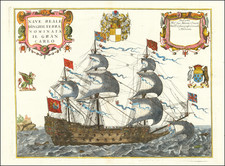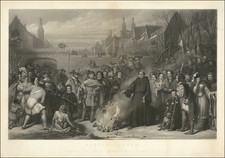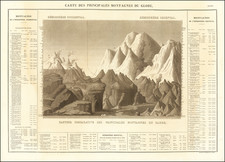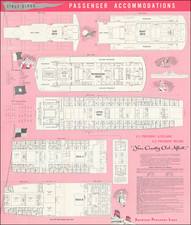Fascinating set of four images offering a window into the customs and practices of ancient Germanic tribes. The print is composed of four distinct scenes, illustrating various aspects of their way of life. The scenes, titled "Der Alten Teutchen Opfer vnd Bottes-dienst," "Ihre Wapen und Ritterspiel," "Ihre Mahlzeiten, und Gastereÿen," and "Ihre Haußhalten und Wohnungen," each highlight a different aspect of Teutonic culture: religious practices, martial activities, feasting, and dwelling, respectively.
The first scene, "Der Alten Teutchen Opfer und Bottes-dienst," translates to "The Ancient Germans' Sacrifices and Worship." This section provides a compelling illustration of the spiritual practices of the ancient Germanic tribes. It includes depictions of sacrificial rituals, showcasing their polytheistic belief system that included a host of gods and goddesses, spirits, and ancestral beings. The scene underscores the integral role that these religious practices played in maintaining social order and seeking divine favor for various endeavors, such as warfare, agriculture, and human affairs.
"Ihre Wapen und Ritterspiel," or "Their Weapons and Knightly Games," depicts the martial prowess of the ancient Germans. The scene features weapons of the era and the depiction of knightly games suggests training or actual combat. This gives an impression of a society that valued bravery, strength, and martial skill, reflecting the warrior ethos that permeated Germanic culture. Moreover, it hints at the importance of chivalrous contests and martial games in social bonding, status negotiation, and preparation for war.
"Ihre Mahlzeiten, und Gastereÿen," or "Their Meals and Banquets," showcases communal dining and feasting, crucial aspects of ancient Germanic society. The image portrays a scene likely filled with food, drink, and camaraderie, reflecting the importance of shared meals in strengthening community bonds. Such feasts often followed sacrifices or marked important communal events, serving both social and religious functions. They offered an opportunity for leaders to display their wealth and generosity, reinforcing social hierarchies.
Finally, "Ihre Haußhalten und Wohnungen," which translates to "Their Households and Dwellings," provides a glimpse into the domestic life of the ancient Germanic tribes. It portrays architectural elements typical of the time, likely including longhouses built with timber and thatch. The depiction of household scenes offers insights into family structure, domestic responsibilities, and the division of labor. It further helps to comprehend the living conditions and daily life of the ancient Germans, thus grounding the image in a tangible reality.
Mathaus Merian (1593-1650) was the father of engraver Matthäus the Younger, and of the painter, engraver, and naturalist Maria Sibylla Merian. He was born in Basel, Switzerland and trained in engraving in Zurich. After a time in Nancy, Paris and Strasbourg, he settled in Frankfurt. While there, he worked for Johann Theodor de Bry, the publisher and son of the travel writer. In 1617, he married Maria Magdalena de Bry, Johann Theodor’s daughter. In 1623, Merian took over the de Bry publishing house upon the death of his father-in-law. Merian’s best known works are detailed town views which, due to their accuracy and artistry, form a valuable record of European urban life in the first half of the sixteenth century









![[ Passport of Lemuel B. Norton ]](https://storage.googleapis.com/raremaps/img/small/48456.jpg)

![(Nuremberg Chronicle) [Saul and Odysseus]](https://storage.googleapis.com/raremaps/img/small/98684.jpg)


